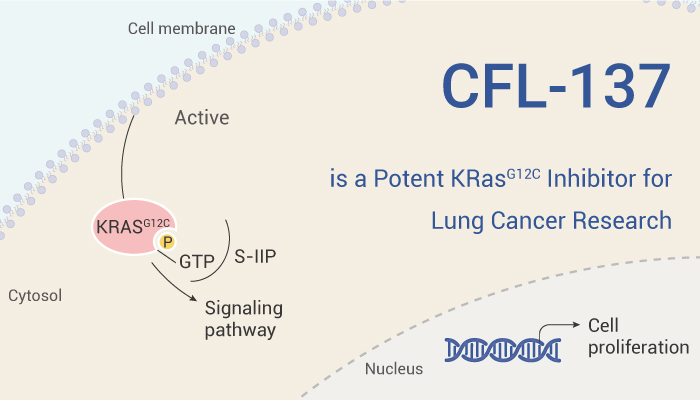KRas (Kirsten rat sarcoma virus) is a part of the RAS/MAPK pathway and relays signals from outside the cell to the cell’s nucleus. Importantly, KRasG12C is a mutation of KRas. Moreover, KRasG12C also is an oncogenic driver mutation. Moreover, KRasG12C mutation has been considered potentially druggable by allele-specific direct covalent inhibition, targeting the nucleophilic cysteine 12 (Cys12) located in the hydrophobic switch-II pocket near the orthosteric binding site of the mutated KRas.
Lung cancer is a malignant tumor that begins in the lung. Particularly, Lung cancer is caused by genetic damage to the DNA of cells in the airways, often caused by cigarette smoking or inhaling damaging chemicals. Moreover, The KRASG12C mutation is found in 14% of non-small cell lung cancer (NSCLC), 3% of CRC, and 1-3% of other solid tumors.
In this article, we will introduce a potent KRasG12C inhibitor, CFL-137.

CFL-137 (72 h) shows an antiproliferative effect with IC50s of 11.4, 24.2, 24.5, 12.3, 43.3, 44.5, 27.63, 32.4, 46.9, 26.2, 25.0, 10.8, 66.2 µM for H1792, SW1573, MiaPaca2, H358, A549, SW480, PANC-1, LCLC-103H, BxPC3, HCA-7, MRC-5, HUVEC-TERT, CCD-986Sk cells, respectively. Besides, CFL-137 (15 mg/kg; i.p.; once) shows good pharmacokinetic parameters with t1/2 of 4.0 h, Cmax of 27366 ng/mL; tmax of 0.25 h, AUCt of 28307 ng/mL*h in NOD-SCID female mice. Meanwhile, CFL-137 (5 mg/kg, 5 treatments; 15 mg/kg, 5 treatments; 30 mg/kg, 3 treatments; i.p.) reduces tumor growth in subcutaneous H1792 (KRasG12C mutant) and LCLC-103H (KRasWT) human lung cancer-bearing mice with the inhibition rate of 32.5%.
All in all, CFL-137 is a potent KRasG12C inhibitor has the potential for the research of lung cancer.
Reference:
[1] Ji J, et al. Onco Targets Ther. 2022 Jul 7;15:747-756.
[2] Orgován Z, et al. Eur J Med Chem. 2023 Mar 15;250:115212.